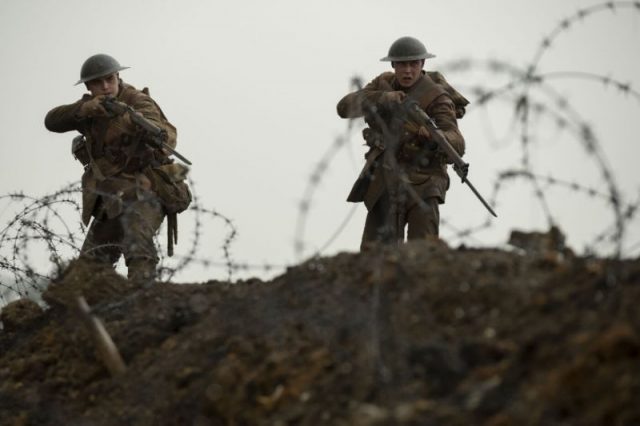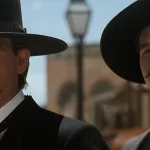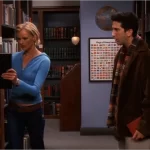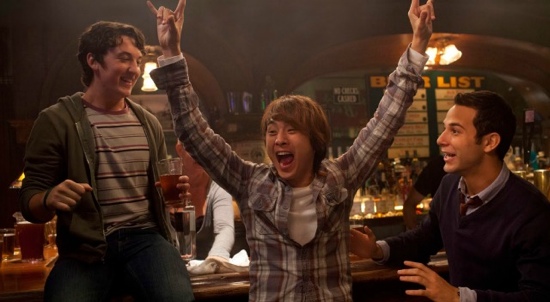1917: Shallow Trench, by Tyler Smith

There is no denying that Sam Mendes’ 1917 is a technical triumph. A war story filmed in a series of long takes (with hidden cuts), the film actively works to put the audience in the shoes of our main characters as they pass through the trenches, battlefields, and ruins of World War I. The fluidity required for the film – not only of camera, but of art direction, sound, and performance – to ascend beyond the point of mere gimmickry is astounding. And the fact that Mendes is able to pull it all off is indeed a cinematic achievement. Sadly, the screenplay at the heart of it is so generic that it makes the film feel less like a fully-realized story and more like a beautifully-executed experiment, leaving me astonished at the spectacle, but ultimately feeling empty.
The story follows British soldiers Blake (Dean-Charles Chapman) and Schofield (George MacKay) as they make their way through enemy territory to warn a cut-off battalion that they are walking into a trap set by the Germans. This could result in the loss of 1,600 troops. Among the endangered soldiers is Blake’s brother, adding a personal incentive to the mission. The two soldiers do their best to avoid being detected, but soon find that danger can come in many forms, including booby traps and collateral battle damage.
Given the “smaller mission within a larger war” nature of the story, it would be easy to compare 1917 to Steven Spielberg’s Saving Private Ryan. However, as the story unfolds and our characters navigate the various obstacles that Mendes throws at them, the film feels much closer to Alfonso Cuaron’s Gravity. Both films feature committed performances by its actors and a consistent, breathless pace. Both films are technical marvels that immerse their audience into impossible situations. And, unfortunately, both feature overstuffed stories and on-the-nose writing.
The events unfolds essentially in real time, which is by its nature a limitation. Only so much can happen in two hours, even in the midst of a chaotic war. Nevertheless, Mendes and co-writer Krysty Wilson-Cairns try to pack in as much material as you’d find in a more standard war movie, from encounters with other battalions to quiet moments with the displaced French locals. These moments have power, but their inclusion in such a specifically-small story play out like a surreal dream instead of the ultra-realistic, grunt’s-eye-view depiction it is attempting to be.
Despite a largely-hollow story, the film is immensely watchable. All of the artists involved work together to create a Hellish world from which there is no escape. Along with the virtuosic camerawork by cinematographer Roger Deakins and seamless editing by Lee Smith, the careful art direction creates an atmosphere of both imminent threat and looming death. As our characters move silently through No Man’s Land, the camera glides along the rotting remains of both German and British soldiers, as well as horses, cows, and dogs.
These haunting images do more to convey the horrors of war than even the most intense on-screen firefight. In these moments, the film speaks volumes about the truly destructive nature of war. And when an important character is killed, and the camera slowly moves beyond him, the realization that he is just one more body among the thousands we’ve already seen is harrowing.
This is the real power of 1917. Much as Mendes may want us to connect with the story being told, it is effective primarily as a means to convey these powerful images of unrelenting horror and endless death. In that respect, this movie deserves to be remembered alongside the great war films, like Platoon, Lawrence of Arabia, and Apocalypse Now. It remains to be seen whether 1917 will have the staying power of those films. If so, it will not be because of its slight screenplay and generic storytelling, but because of the director’s willingness and ability to fully transport the audience to a place they would never want to go.





























Did it ever evoke Paths of Glory for you? The beginning section?
Absolutely. I actually use the scene of the general walking through the trench in PATHS OF GLORY when talking about long takes to my students. So, yes, it’s the first place my mind went. In a way, the long take is probably the most natural way to film a character walking a WWI trench. It just lends itself to it.
-Tyler